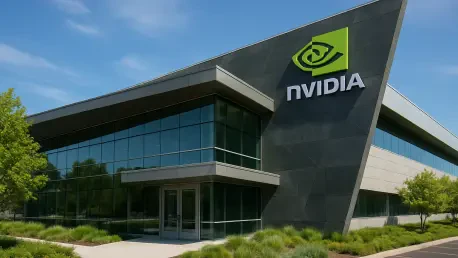As NVIDIA Corporation (NVDA) prepares to disclose its second-quarter earnings on August 27, the tech giant’s lesser-discussed networking technologies are emerging as a potential centerpiece for investors and market watchers. Renowned primarily for its cutting-edge AI processors, NVIDIA has quietly built a formidable presence in data center networking—a segment critical to powering the AI revolution. This often-overlooked aspect of the company’s portfolio, encompassing solutions like NVLink, InfiniBand, and Ethernet, is gaining traction for its role in enabling high-speed, seamless communication within sprawling data center architectures. Amid an unprecedented surge in demand for AI computing power, this hidden driver of growth could redefine how NVIDIA’s value is perceived. With financial contributions already outpacing other divisions and technical innovations underpinning AI performance, the stage is set for networking to command significant attention in the upcoming earnings reveal.
Unveiling a Financial and Technical Powerhouse
Networking’s Rising Revenue Contribution
NVIDIA’s data center business has been a juggernaut, with total revenue reaching an impressive $115.1 billion in the last fiscal year, a figure that underscores the company’s dominance in AI infrastructure. Within this, the networking segment carved out a substantial $12.9 billion, surpassing even the gaming division’s haul of $11.3 billion. This achievement highlights how networking, though not as celebrated as GPU sales, is becoming a cornerstone of NVIDIA’s financial success. In the first quarter of the current fiscal year, data center revenue climbed to $39.1 billion, with networking alone contributing $4.9 billion. Such consistent growth signals that this segment is not merely a supporting act but a vital engine driving NVIDIA’s expansion in a market hungry for AI solutions. As enterprises and tech giants continue to invest heavily in data center capabilities, the financial impact of networking is poised to grow even further, potentially reshaping investor focus in the coming quarters.
This upward trajectory of networking revenue stands in stark contrast to earlier perceptions of NVIDIA as primarily a GPU-focused entity. Unlike the gaming segment, which often fluctuates with consumer trends, networking benefits from the steady, long-term demand for AI infrastructure across industries. The $4.9 billion recorded in Q1 is not just a number but a testament to the segment’s resilience and relevance in an era where data centers are the backbone of technological advancement. Analysts are beginning to recognize that while GPUs capture headlines, networking quietly ensures the scalability and efficiency that make AI systems viable at an enterprise level. This shift in financial dynamics suggests that NVIDIA’s diversified approach within data centers could provide a buffer against volatility in other markets, positioning networking as a critical area to watch in the earnings report.
The Technical Core of AI Efficiency
At the heart of NVIDIA’s data center prowess lies its networking technologies, which serve as the invisible glue connecting GPUs and servers into unified, high-performance systems. Solutions like NVLink enable rapid communication between GPUs within and across servers, while InfiniBand links server nodes for cohesive data center operations, and Ethernet handles storage and management tasks. As Gilad Shainer, NVIDIA’s Senior Vice President of Networking, has emphasized, this infrastructure is fundamental to building supercomputers capable of tackling the most demanding AI workloads. Without such high-speed connectivity, even the most powerful GPUs would falter, bottlenecked by delays in data transfer. Networking ensures that AI systems operate as a singular, efficient unit, a necessity in today’s landscape of sprawling data architectures.
Beyond mere connectivity, NVIDIA’s networking solutions are tailored to address the dual challenges of AI training and inference. Training massive AI models requires immense computational power, but inference—running these models in real-world applications—has grown equally demanding with the advent of complex, autonomous systems. Networking technologies minimize latency and maximize throughput, ensuring that data flows smoothly between components regardless of workload type. This capability is not just a technical advantage but a strategic one, positioning NVIDIA to meet the evolving needs of AI developers and enterprises. As data centers expand to handle increasingly sophisticated tasks, the role of networking as a performance enabler becomes undeniable, cementing its status as a linchpin of NVIDIA’s technological leadership.
Navigating Market Dynamics and Challenges
Surge in AI Demand and Infrastructure Needs
The explosive growth of AI adoption across sectors has created an insatiable appetite for robust data center infrastructure, placing NVIDIA’s networking segment at the forefront of this transformation. From research institutions to global tech giants, organizations are racing to develop larger, more intricate AI models that require unprecedented computing power and connectivity. Networking technologies are no longer just an accessory but a prerequisite for ensuring that these systems operate without hiccups. The ability to facilitate rapid data transfers between chips and servers is critical, especially as AI workloads expand beyond traditional training to encompass real-time applications. This trend underscores why NVIDIA’s solutions are becoming indispensable in a market driven by the need for speed and scalability.
Equally significant is the shifting nature of AI workloads, particularly the rising complexity of inference. Once considered a lighter task compared to training, inference now demands high-performance systems as autonomous “agentic workflows” emerge, requiring continuous, efficient processing. NVIDIA’s networking infrastructure, designed to integrate seamlessly with GPUs and data processing units, is uniquely equipped to handle these escalating requirements. This adaptability ensures that data centers can support not only current AI applications but also future innovations that push computational boundaries. As industries lean further into AI-driven automation, the demand for such integrated solutions will likely intensify, positioning networking as a key growth area for NVIDIA in the years ahead.
Competitive Pressures and Strategic Advantages
While NVIDIA currently holds a commanding lead in the AI and networking space, the competitive landscape is heating up with rival chipmakers and cloud giants like Amazon, Google, and Microsoft developing their own AI chips. Additionally, industry initiatives such as UALink—a direct competitor to NVLink—are gaining traction as alternatives to NVIDIA’s proprietary technologies. These emerging challenges highlight the dynamic nature of the market, where innovation and adaptability are paramount. Despite this, NVIDIA’s comprehensive ecosystem, which tightly couples hardware with networking solutions, offers a distinct edge that competitors struggle to replicate. This integration is particularly appealing to customers scaling AI operations, as it simplifies deployment and enhances performance.
Moreover, NVIDIA’s strategic focus on networking as a core component of its data center offerings provides a buffer against competitive threats. Industry observers, including Gene Munster of Deepwater Asset Management, have noted that while networking accounts for roughly 11% of revenue, its rapid growth trajectory could soon draw as much attention as other segments. The ability to deliver end-to-end solutions—combining GPUs, CPUs, and networking—sets NVIDIA apart in a crowded field, ensuring that customers remain within its ecosystem. As the Q2 earnings approach, this competitive resilience, paired with networking’s technical and financial contributions, suggests that NVIDIA is well-prepared to maintain its dominance, even as rivals seek to close the gap.









